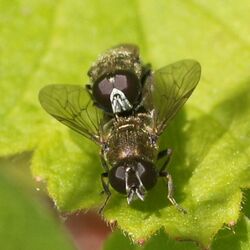Biology:Eumerus funeralis
| Eumerus funeralis | |
|---|---|

| |
| Mating pair | |
| Scientific classification | |
| Kingdom: | |
| Phylum: | |
| Class: | |
| Order: | |
| Family: | |
| Subfamily: | |
| Tribe: | |
| Genus: | |
| Species: | E. funeralis
|
| Binomial name | |
| Eumerus funeralis Meigen, 1822
| |
| Synonyms | |
|
Eumerus tuberculatus Rondani, 1857 | |
Eumerus funeralis or lesser bulb fly[1] is a species of Hoverfly, from the family Syrphidae, in the order Diptera.[2][3] E. funeralis appears in Peck (1988) as a synonym of E. strigatus (Fallen), but was reinstated as the correct name for tuberculatus Rondani, sensu auctorum by Speight et al. (1998).
Description
External images For terms, see: Morphology of Diptera.
Wing length: 3.5–6 mm (0.14–0.24 in). Stigma are dark brown blackish. Femur 3 has a small ventral process at the base and apical to this projection a bare, shiny area. Female has frons with a large and squarish shiny area occupying its entire width except for the narrow white dust strips against the eye. Tergites are blackish, no red-brown markings. Van Veen, M. (2004) figures the male genitalia.[4][5][6][7] The larva is illustrated by Rotheray (1993) [8]
Distribution
Originated in the Mediterranean basin, but becoming cosmopolitan, especially in the Palaearctic and Nearctic.[9] [10][11]
Biology
The habitat is open ground, dry grassland and clearings in dry woodland.[12] Occurs also in suburban gardens and land used for horticulture. Flowers visited include Euphorbia, Fragaria, Leucanthemum, Ranunculus. The flight period is April to September, with peaks in June and August. The larva is phytophagous, feeding in damaged bulbs. Minor pest of Amaryllis, Hyacinthus and Narcissus.[13]
References
- ↑ Stubbs, Alan E.; Falk, Steven J. (2002). British Hoverflies: An Illustrated Identification Guide (2nd of Revised ed.). British Entomological and Natural History Society. pp. 469. ISBN 978-1899935055.
- ↑ Stubbs, Alan E.; Falk, Steven J. (1983). British Hoverflies: An Illustrated Identification Guide. British Entomological & Natural History Society. pp. 253, xvpp.
- ↑ Van Veen, M.P. (2004). Hoverflies of Northwest Europe, Identification Keys to the Syrphidae (hardback). Utrecht: KNNV Publishing. pp. 254. ISBN 90-5011-199-8.
- ↑ Van Veen, M. (2004). Hoverflies of Northwest Europe: identification keys to the Syrphidae. 256pp. KNNV Publishing, Utrecht.addendum
- ↑ Van der Goot, V.S. (1981). De zweefvliegen van Noordwest - Europa en Europees Rusland, in het bijzonder van de Benelux. KNNV, Uitgave no. 32: 275pp. Amsterdam.
- ↑ Bei-Bienko, G.Y. & Steyskal, G.C. (1988) Keys to the Insects of the European Part of the USSR, Volume V: Diptera and Siphonaptera, Part I. Amerind Publishing Co., New Delhi. ISBN:81-205-0080-6.
- ↑ Coe, R.L. (1953). Diptera: Syrphidae. Handbooks for the Identification of British Insects 10(1): 1-98. Royal Entomological Society of London. pdf
- ↑ Rotheray G., 1993 Colour Guide to Hoverfly Larvae Diptera, Syrphidae in Britain and Europe Dipterists Forum pdf
- ↑ Fauna Europaea
- ↑ Peck, L.V. (1988) Syrphidae. In: Soos, A. & Papp, L. (eds.) Catalogue of Palaearctic Diptera, 8: 11-230. Akad. Kiado, Budapest.
- ↑ Vockeroth, J.R. (1992). The Flower Flies of the Subfamily Syrphinae of Canada, Alaska, and Greenland (Diptera: Syrphidae). Part 18. The Insects and Arachnids of Canada. Ottawa, Ontario: Canadian Government Pub Centre. pp. 1–456. ISBN 0-660-13830-1.
- ↑ Speight, M.C.D. (2011). "Species accounts of European Syrphidae (Diptera)". Syrph the Net, the database of European Syrphidae 65: 285pp. http://www.diptera.info/downloads/StN_Species_Accounts_Glasgow_2011.pdf.
- ↑ de Buck, N. (1990). "Bloembezoek en bestuivingsecologie van Zweefvliegen (Diptera, Syrphidae) in het bijzonder voor België". Doc.Trav. IRSNB, no. 60, pp. 1-167.
Wikidata ☰ Q5409565 entry
 |

